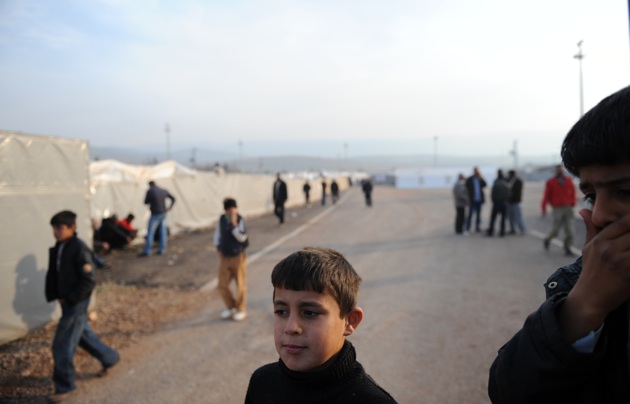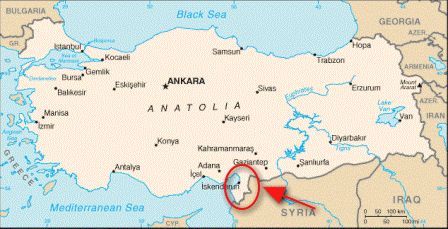Over the past ten days, the alarming flight of more than 11,000 Syrians to Turkey—and the prospect of thousands more to come—has brought the international press to Hatay, the dusty Turkish border province with a large Syrian minority where most of the refugees have been put in camps. With impressive speed, Turkey’s Red Crescent has launched a large-scale humanitarian effort to provide a safe haven for victims of Assad’s horrific crackdown. But while journalists seek to interview those who have fled, they have also had to confront a surprisingly recalcitrant Turkish government: for more than a week after the refugees arrived, access to the camps where they are being housed was [denied] (http://www.hurriyetdailynews.com/n.php?n=turkey-allows-limited-access-to-syrian-refugee-camp-2011-06-19); and Turkey has until now refused support from international humanitarian agencies to deal with the crisis. Still more puzzling, some Syrians who had taken refuge with expatriated relatives have also been moved to the camps where contact with their kin is difficult.
What is Ankara so nervous about? There are of course many reasons for Turkish qualms about the refugee situation—not least Turkey’s careful cultivation of the Assad government in recent years, which has already put it in an awkward position in relation to the Syrian revolt (though it did host a Syrian opposition conference in early June). Largely overlooked, however, is the history of Hatay itself—a region that, until 1939, belonged to Syria and to this day [appears as part of Syria] (http://www.parliament.gov.sy/ar/syria.php) on [Syrian maps] (http://www.syriatourism.org/modules/My_eGallery/public/nmpopupa.php?z=/servers/gallery/20070613-161610.jpg&n=123457746). Geography, moreover, seems to be on Syria’s side: jutting south from Turkey’s otherwise consistent border along Anatolia’s southern edge, the province is connected to the rest of Turkey by the mountain pass known since the time of Alexander the Great as the Syrian Gates; it creates a narrow Turkish corridor in the Levant that cuts off northern Syria’s access to the Mediterranean.
Indeed, Syria has never officially recognized Turkish sovereignty over Hatay, and as recently as the late 1990s, Syria’s support for separatist Kurds in the disputed region pushed the two countries to the brink of war. Moreover, Hatay’s population has large non-Turkic minorities. There are Christians and Sunnis of Arab descent as well as Kurds; there are also Arab Alevis, a minority religious community that in this part of Turkey follows the same syncretic faith as the [Alawites in Syria] (http://www.nybooks.com/articles/archives/2011/jun/09/storm-over-syria/) who dominate the Syrian government and mukhabarat. With this history and population, it becomes clearer why the Turkish government might worry that the arrival of tens of thousands of Syrian Sunnis could cause sectarian tensions to spill into Turkish territory.
As The Independent has [reported] (http://www.independent.co.uk/news/world/middle-east/turkey-feels-racial-tensions-as-flood-of-syrian-refugees-goes-on-2297550.html?service=Print), there has already been at least one protest in the Turkish border town of Samandag by Turkish Alevis who are against allowing in (mostly Sunni) Syrian refugees to Turkey. With hundreds of Syrians crossing each day–and growing reports of Alawite-Sunni violence in Syria’s northwest—such opposition in Hatay’s border villages, several of which have concentrations of Alevis, could gain strength. (One apparent reason Syrians are crossing into Hatay and not into other Turkish provinces further east along Syria’s long northern border with Turkey is that other parts of northern Syria include areas dominated by Syrian Kurds, who have reportedly been far less affected by the crackdown and hence have not been compelled to flee the country.)
For the moment, the possibility of broader sectarianism taking hold in southern Turkey seems remote. During a visit to Hatay and its provincial capital, Antakya (modern day Antioch) over the past few days, I was struck not by the extent of ethnic and sectarian division, but quite the opposite: within a stone’s throw of Antakya’s main Sunni mosque (itself a converted crusader church) is one of the most imposing orthodox cathedrals in Turkey, where mass is celebrated in Arabic; not much father down the main street is a synagogue that continues to serve the tiny local Jewish population. There is also an Alevi house of worship. Cell phones operate on Syria networks here. The delicious local cuisine is more Levantine than Anatolian—the signature dish is Kanafeh (Künefe in Turkish) a sweet made of shredded phyllo pastry and (in Antioch) a special local cheese that has been common in the Arab middle east for centuries. If you don’t speak Turkish, Antiochene shopkeepers will switch to Arabic; and in some parts of the city street signs are posted in both languages. For a sleepy backwater on the unprepossessing Orontes River, Antakya is improbably cosmopolitan.
Advertisement
Moreover, journalists who have visited other Turkish villages along the border report that, for the most part, the plight of the refugees—many of whom are Sunnis from the besieged town of Jisr al-Shughour just across the border, where there have been [exceptionally violent clashes] (http://www.bbc.co.uk/news/world-middle-east-13857654) between protesters and security forces over the past month—has been taken in stride. (For some, it is also a business opportunity, as the Turkish government struggles to staff and maintain the rapidly growing camps it has set up.) And regardless of possible Alevi opposition, many Hatay villagers are Sunnis (both Turk and Arab) who seem to have welcomed their Syrian brethren.
Yet the Turkish government may find reasons to be insecure in the not quite resolved legacy of the 1930s, when the region then known as Alexandretta (after the principal Mediterranean port, to the northwest of Antioch) and belonging to the French Mandate of Syria was more or less reinvented as a Turkish province. Under the mandate, Alexandretta was predominantly Arab and Armenian though it had a sizable Turkish minority; according to one report, in 1921, there were some 87,000 Turks amid a population of 220,000. By the mid-1930s, however, there was growing Turkish interest in annexing the region, which had strategic value, and in an initial agreement brokered by the League of Nations, the French (who sought Turkish support against the Nazis) agreed to turn it into a short-lived autonomous republic, the Republic of Hatay. According to Syrian accounts, the Turkish military expelled many Arabs and Armenians (some of whom [fled] (http://www.highbeam.com/doc/1P2-5160074.html) to Lebanon) from the region, however, and in 1939 Turkey annexed it, following a referendum in which Arabs had boycotted and large numbers of Anatolian Turks were reportedly sent into the region to vote in favor of Turkish sovereignty.
Following annexation, the region was subject to [Turkification] (http://www.culturalsurvival.org/ourpublications/csq/article/for-reasons-out-our-hands-a-community-identifies-causes-language-shift)—both through enforced use of Turkish and by inflow of Turks—and to the passing visitor it seems to have assimilated itself to a considerable degree to the Turkish state. It is not hard to find younger Hatay residents of Arab descent who no longer speak Arabic, or do so only at home with their parents. But it is also hard to miss the message of public monuments such as the statue of the “Commander of Turkish forces who entered Hatay on July 5, 1938”—for a population that today feels closer to Aleppo, its main trading partner just sixty miles away, than Ankara six times as distant to the north.
For Syria, the loss of Alexandretta is viewed as a dirty deal between the Turks and the French. Syrian officials have likened it for decades to the Golan Heights—territory that was taken away from Syria and should be reclaimed. Paradoxically, one of Turkish Prime Minister Erdogan’s foreign policy initiatives in the early 2000s was to quietly bring this dispute to an end, in part, it appears by proffering enhanced trade with and support for Syria—including, not least, an attempt to help mediate with Israel that other border dispute, the Golan. According to some reports, an [unofficial deal] (http://www.danielpipes.org/blog/2005/01/is-the-hatayalexandretta-problem-solved) was reached in the mid-2000s, whereby Syria would drop its claim to Hatay for the foreseeable future in exchange for getting a free trade agreement and water rights from Turkey, though it was never formally acknowledged by either side.
Now that Syrian forces are moving close to the border, reportedly [cutting off the escape route] (http://www.guardian.co.uk/world/2011/jun/23/syrian-refugees-turkey-border-crossing) for refugees, that rapprochement seems from a different era. And with the prospect of a possible [military response] (http://www.todayszaman.com/news-247894-syrias-operations-close-to-border-may-spark-clash-with-turkey.html) by Turkey in the event of a further escalation across the border, it may be increasingly difficult to ignore Hatay’s complicated history.



